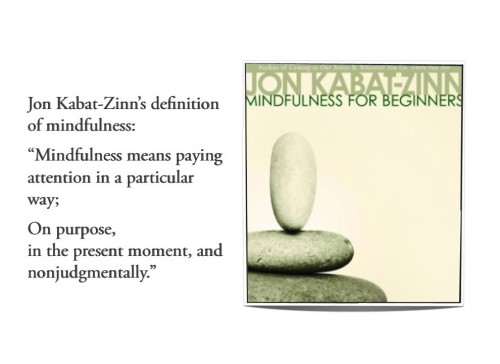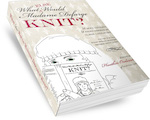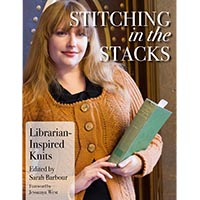Chapter 2.2—Mind Full or Mindful
In the previous post this week, we ended by talking about being an expert vs. being “automatic” in your knitting, crocheting, throwing pots, gardening, or doodling. I’m willing to bet that there are quilters and embroiderers, too, (not me; my embroidery is appalling) who can get into an automatic “zone,” though to my mind, you need to use your eyes much more when embroidering and quilting (a factor we’ll get to soon) and that could get in the way of the kind of automaticity we’re aiming for.
But I digress.
The really nice part about what I’ve researched is this: most knitters and crocheters don’t NEED to become experts to derive benefits from their craft—we only need to achieve automaticity, and if you knit or crochet a little every day, it won’t take you 10,000 hours or 10 years to get to that point. You know you’re a truly automatic knitter where you can knit a plain vanilla sock in a darkened movie theater (maybe not the heel turn, but around and around), or you can work a simple lace repeat without looking, or you can crochet an amigurumi while listening to what could have been a really boring lecture. One CraftLit listener even wrote to tell me that she listened to the podcast while knitting a sock while on a treadmill! (Automatic multitasking?) So that’s it! That’s the only point you really need to get to in order to get benefits to your brain.
Because when you’re at a point where what your hands are doing has become a habit, then the habit can become mindfulness.

by Henck van Bilsen, Consultant Cognitive Behaviour Therapist & Consultant Clinical Psychologist. It is from his book, The Socks of Doom
When you sit down to knit, do you feel like the guy on the left?
And while you’re knitting do you start to feel like the happy doggie on the right?
I think when people start talking about the “process” vs “product” knitters and crocheters this is what they’re really getting at. And like Kathleen commented on in an earlier post — the chances of a crafter only being a process knitter (one who says it’s the journey they’re after) or only being a product knitter (one who says they just want to get it done so they can wear/give/admire the thing they’re making) are mighty slim. This is particularly true if you’re a polygamous crafter.
Some days I want to think. Those days, the crafts I pick up, are the crafts that challenge me, that make me think, that are examples of Deliberate Practice.
Some days I’m tired. I don’t want to think. I just want to relax. Those days are the days when I pick up a vanilla sock or a vanilla shawl. Those are the days when I enjoy my automaticity.
What I’ve learned from research and from my own experiences with this, is that both of these activities are mindful—they both get me to the doggie on the right. But they do it different ways.
Deliberate Practice—lace or complex knitting—puts me in a state of mindfulness when it’s just me and the yarn and the needles. I’m focused; I’m watching; I’m absolutely in the moment and I feel 100% refreshed and energized when I put the work down.
Automatic knitting—vanilla crocheting or endless stockinette on a sweater back—puts me in a state of mindfulness because it calms my Monkey Mind and allows me to focus on something else: a lecture, a staff meeting, a group of friends who all talk really fast, an audiobook, a podcast.
Both of these activities cognitively anchor me, albeit in different ways, to different things, and achieve different purposes.
With Deliberate Practice I’m absolutely anchored to the task. Everything else fades into the background and I’m watching (the eyes, again) the stitches as I count or shape my work.
With automatic knitting I’m absolutely anchored to whatever I’m watching-and-listening to. This is what I need to do in order to attend to a staff meeting, a hard-to-follow conversation, a conference call or webinar. This is the kind of anchor that other people seem not to understand.
People-who-don’t-get-it aside, researchers have found that training you to be more mindful not only aids in sharpening one’s focus (yarny sudoku?) but also gives you a way to help manage your mood.
What is crafting if not a training course in both kinds of mindfulness?
3 Comments















Wow! Before reading this chapter I would have heartily agreed with the lace knitting example of mindfulness (a practice that has been introduced to me during therapy) but I would never have thought of the automatic ‘mindless’ knitting as mindfulness too. But it makes perfect sense, I struggle to settle to meditation (or even to watch a TV programme) as I am always thinking about the hundred and one things that I need to do, but when I am knitting my simple projects I can completely pay attention to something like Craftlit! Thank you for the insight.
I completely agree. It was the same for me as I started researching this! And it makes so much sense—especially in light of the emails I get from listeners who do all sorts of things when they listen to CraftLit—all of them active, but all of them automatic (gardening, knitting, crocheting, pot-throwing, vacuuming, cooking, doing dishes, dusting, jogging). Their emails make it clear that they’re paying close attention to the podcast, but there they are, gardening away!
I think all this, too, is very different from what we think of nowadays as “multitasking”.
Interestingly enough…I believe I’ve practiced mindfulness with a vanilla sock during a course on property and casualty insurance (I was working on getting licensed). I was able to knit while listening to the instructor, and had no difficulty passing the exams. At the time I didn’t know what it was, but I do know that the knitting made me less fidgety. I start a new job tomorrow, and am hoping that all of the orientation videos I know I will have to watch will allow me to get some mindless knitting done.